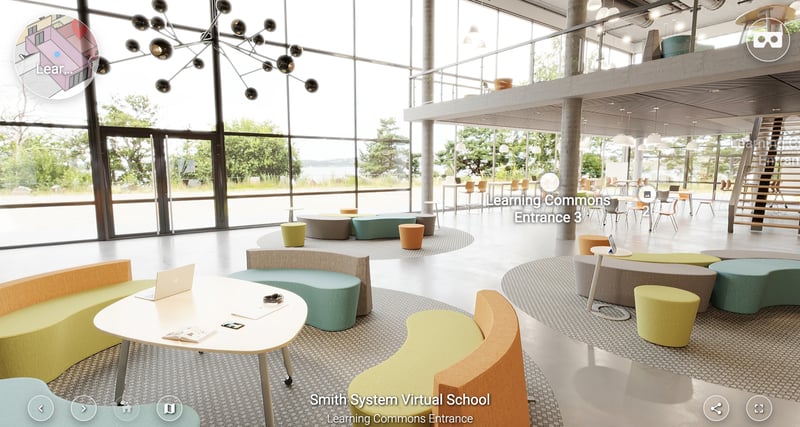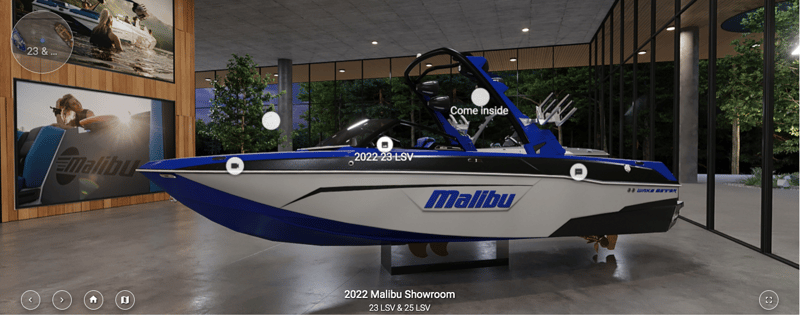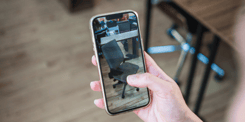Welcome to our first post of 2022 - we hope you all had a fantastic time ringing in the New Year and have had the chance to settle back into your normal routine.
We wanted to kick off this brand new year with a special focus on VR and Business. From what you can expect from VR in 2022 to headsets on the horizon, join us this month to get the tips, tricks, and key industry insights that will set you up for success.
To start us off in the new year, we’re sitting down with Christine Bellefontaine, Yulio’s Director of Marketing, as she shares her expertise on how you can select and implement the right VR tools as well as how this technology is able to fit into your processes and sufficiently support your in-person or remote teams. Plus, learn more about marketing with VR and how you can start properly equipping your teams to sell more now and for years to come.
1. Since the beginning, we have said that VR is a powerful marketing machine. What does this mean?
CB: Most marketers of products or services would tell you that if they could just get their prospects to picture themselves using the product, their jobs would be done. That’s what marketing is about - making people see a vision of themselves using a product that solves a problem or meets a need. And when you start talking about sharing a vision or letting someone picture themselves inside something or doing something - now you're overlapping with the best elements of VR storytelling.
That’s exactly what VR can do. It puts people into scenarios and lets them acquire complete understanding. And if you think it’s not really that dramatic to picture yourself somewhere - just watch someone in a VR headset who starts to move, and duck and turn their head - it is transportative.
2. In your opinion, what are the top 3 reasons why immersive technologies are so effective in marketing initiatives?
CB: Firstly, it’s memorable.
VR in business use cases is still a new enough technology that people remember your brand - it stands out from the crowd just from giving people a new experience. But more than that, immersive visuals are retained in memory better. Research in using VR in education says that people who experience VR have about 10% higher recall than those who don’t. Our brains are wired to have greater recall when we leverage senses like movement, speed, and spatial positioning along with a story or piece of information.
Secondly, it builds confidence and trust.
VR can create a true ‘try before you buy’ experience that gives customers the confidence to say ‘yes’. I like to think about this in terms of architecture or interior design - words like “modern” or “traditional” is pretty vague when you’re describing a style - and sure, you can show someone a mood board or samples. But showing them exactly how their own space will look? That’s pretty powerful. One of my colleagues has said that it’s the difference between going to the park...and looking out the window at a park and it’s a pretty apt analogy.
If someone is going to sign off on a pretty significant purchase of furniture or flooring or whatever it may be...is it really fair to ask them to ‘picture it’ from a swatch or sample? That leads to customer responses like “I’ll think about it” and more meetings. VR takes that hesitation away - it’s the end of “picture it like this but…” and clients feel much more confident making a final decision.
And finally, it proves what’s possible.
With VR we can put someone in a scenario. Some charities who have used VR videos and other ways to put potential donors in the world of those they want to help have seen significant increases in donations...all because people could really see what their money might help achieve. Charity: water showed donors a film of a young woman and the journey of her family getting access to clean water for the first time - they beat the event’s prior year total donations by 2.4 million and the film went on to have thousands of youtube views. It showed what’s possible.
In very practical terms, it also quite simply takes away concerns about whether or not something will ‘work’. Macy’s had tremendous success with a VR room planner to sell more furniture because people had greater confidence about how things would fit and look in their space.
VR lets a client envision themselves in a scenario, a space, a world, that doesn’t exist yet - could they fit that couch in their living room? Could they make a difference in a young woman’s life? Could they take a cruise without feeling claustrophobic? It’s a confidence booster.
3. Who can benefit from using virtual reality in marketing?
Many of the industries we work with, including architects, designers, and commercial furniture companies have built expertise around understanding space planning and how elements fit together - but their clients don’t have inherent understanding. So marketing their services becomes a bit like trying to translate a 2D portfolio into a real-life environment and many people just aren’t that good at picturing all the elements. So pretty much any time you want your clients or customers to ‘picture’ something - that’s VR
The best scenarios we’ve found for using VR include -
- Showing something that doesn’t exist yet
- Showing something that is far away
- Or something that is large or expensive to model
Many of those use cases come from marketing uses - showing real estate or even an interior design that is yet to be started, showing travel experiences or projects happening around the world, and showing off things like vehicles where it’s hard to have live samples of every model, in every trim level and every color.
The bottom line is that VR isn’t about gaming or technology - it’s about telling visual stories and when you’re telling your best story to a customer who can put themselves in a scenario it creates some pretty powerful marketing.
4. And I know it’s hard to pick favourites, but any winning VR marketing use cases that come to mind that particularly stood out to you?
My favorite examples are always the ones that show how it’s actually such a practical tool. I think people hear “VR” and have visions of helmets and complex computing - and it’s just not like that. It’s about making something you already do even better. So from that perspective, I guess I’d say our friends at Smith System have really knocked it out of the park. They design and sell furniture for education and schools - and with our VR tools, they’ve built an entire virtual school where you can see all the products in context, see the dynamic ways the same pieces can be arranged, and just really get a feel for what’s possible. I love that they are finding they can book more meetings for people touring their virtual showroom than they used to in-person - clients don’t have to travel and feel more in control of their time.
We have other showrooms too - Malibu boats have built an absolutely stunning, realistic one to show off their products - you can see it in the showroom, see how it looks from inside and narrow down all your options before contacting sales.
But really, I just love any of our client stories where people get to the ‘aha’ moment faster - that’s what it’s about - from the architects whose clients said “oh that’s why it has to be so big” to the salespeople who closed faster because their competition couldn’t show clients a full solution - there are so many great and creative uses.
5. When it comes to choosing the right platform, what should people look for?
For marketers, it’s going to be all about the sharing - stunning projects don’t have nearly as much value if you can’t leverage them across things like your social media or your website portfolio. So you want something that can be viewed outside the design software it was created in - ideally something you can share with just a URL like any post.
So, obviously on social media that’s not a true headset / VR experience - it’s a 360 experience you can pan around and tour. So you need a platform that treats that like a first-class experience too.
And something that functions well when you have it embedded in your website - a VR project can create a great moment of interaction and ‘stickiness’ for your page - and hint to prospects that you embrace technology and that they can expect that kind of visualization when they work with you.
6. And finally, any tips or last pieces of advice?
Just that it’s time to get started. Offering VR or AR visuals to your clients are going to become table stakes for RFPs or just for selling large-scale projects and items. So stop waiting for the market to settle - we’re past that. One technology isn’t going to win over the other - they are completely different and have their own use cases, so trying to wait until it’s clear which one to adopt will mean you are trailing your competitors. To be clear VR is a window on something that doesn’t exist yet. It’s always going to be best for showing concepts, for letting people visualize an environment, and for large scale. AR is something that’s going to be on a person’s phone, it’s going to be for smaller-scale purchases, checking how an object interacts with the physical world. The two will remain different, for different use cases.
The companies that best weathered the pandemic are those that had a culture of embracing technology - video conferencing, project management, and digital tools. Being ready, getting ‘experimenting’ out of the way, and starting to integrate digital realities in your workflow now means you’ll be ready when it’s necessary. And as, a full year later, it has become clear that a return to old methods of communication is still in the distance, and will likely never return completely to the old ways, holding off increasingly feels like holding your business success back. Getting started now will be critical to meeting the challenges of a work environment that are forever changed.
Thank you to Christine for her time and for sharing her expertise in marketing with VR. If you're ready to get started with VR, we have a 30-day free trial that you can sign up for today (no strings attached). So create your account in just a few minutes and start creating today! For more information on VR and how the tech can be a huge ROI driver, check out this whitepaper piece that will answer your questions and walk you through exactly how you can experience success with VR.








.jpg?width=245&height=150&name=iStock_88161583_XLARGE%20(1).jpg)
